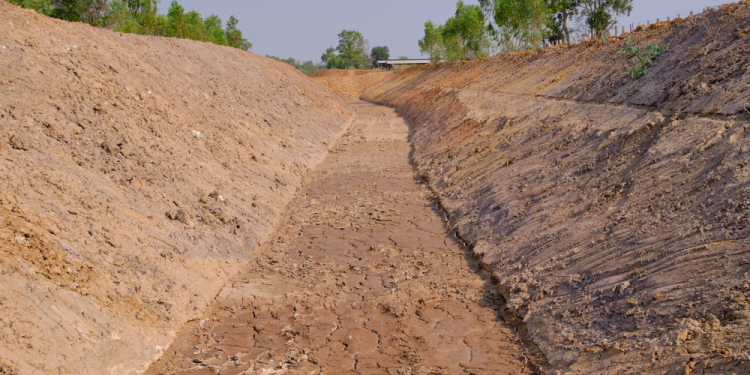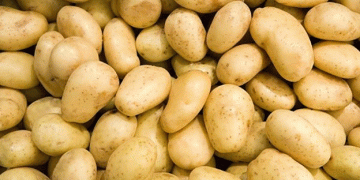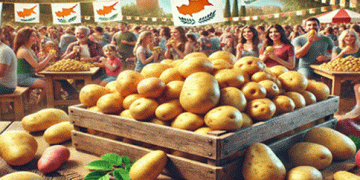As a historic drought ravages farms and ranches throughout the Klamath Basin on the California-Oregon border there are visible signs of the calamity everywhere. Fields lie fallow. There are dust storms in spring. Some days it seems there are as many meetings about the future as crops being planted.
But for Tricia Hill, a fourth-generation potato farmer of Czechoslovakian immigrants, there is something else: The eerie silence of the fields. With little water filling the canals or crops in the ground also largely missing are the sounds of rural life, from tree frogs to red-winged black birds to the methodical hum of wheel line irrigation equipment. Compromised as well are the timeless rhythms of agriculture, starting with planting season and continuing past the first cut of hay.
“There is some normality but it gets punctuated by these moments of gut punches of reality by a lot of things that are different … and not knowing when the next reminder is going to come that nothing is the same,” she said. Hill left home to attend the University of Oregon where she earned a “double duck” – an undergraduate degree in environmental studies and then law school.
She knew she made the right decision to return home and raise a family but never more so than at a tractor rally outside Klamath Falls, Ore., last year where a steady stream of farm vehicles showed up clogging highways in support of agriculture. Hundreds of small white crosses were planted in a field representing the passing of family farms in America.
“It was pretty emotional,” she said. “We are tired of living in systematic chaos and want something better for our community.” Hill currently works as a potato processor and is busy with the few farms lucky enough to have well water. But she said government intervention has only made things worse. “The idea that we are going to just push a button … and fix a complicated ecological system is ludicrous,” she said. “It is no wonder we have failed for the last 20 years.”
For nearly a century, the Klamath Basin survived periodic droughts, an invasion of jackrabbits, and a temporary shortage of tractor parts when a local dealership closed. Veterans of both World Wars who won a lottery by having their names pulled from a pickle jar were promised water for life if they agreed to irrigate an arid landscape in the second-oldest U.S. Bureau of Reclamation project on record.
Then came the fish.
In a series of federal court rulings, endangered fish, including Coho salmon and the Lost River sucker, were given first priority over water that has left farmers with a flood of uncertainty. Estimated water deliveries this summer were expected to be 5 percent of normal. Many remained skeptical even that would happen. Those fears were confirmed on Tuesday when the Bureau of Land Reclamation, which oversees water deliveries on federal lands, announced that due to “increasing extreme drought conditions” there will be no water, period.
‘It Will Look Like the Sahara Desert’
“It is a big problem,” said Ben DuVal, president of the Klamath Water Users Association. “It will look like the Sahara Desert by the end of summer. You will be losing soil.”
And not just any soil.
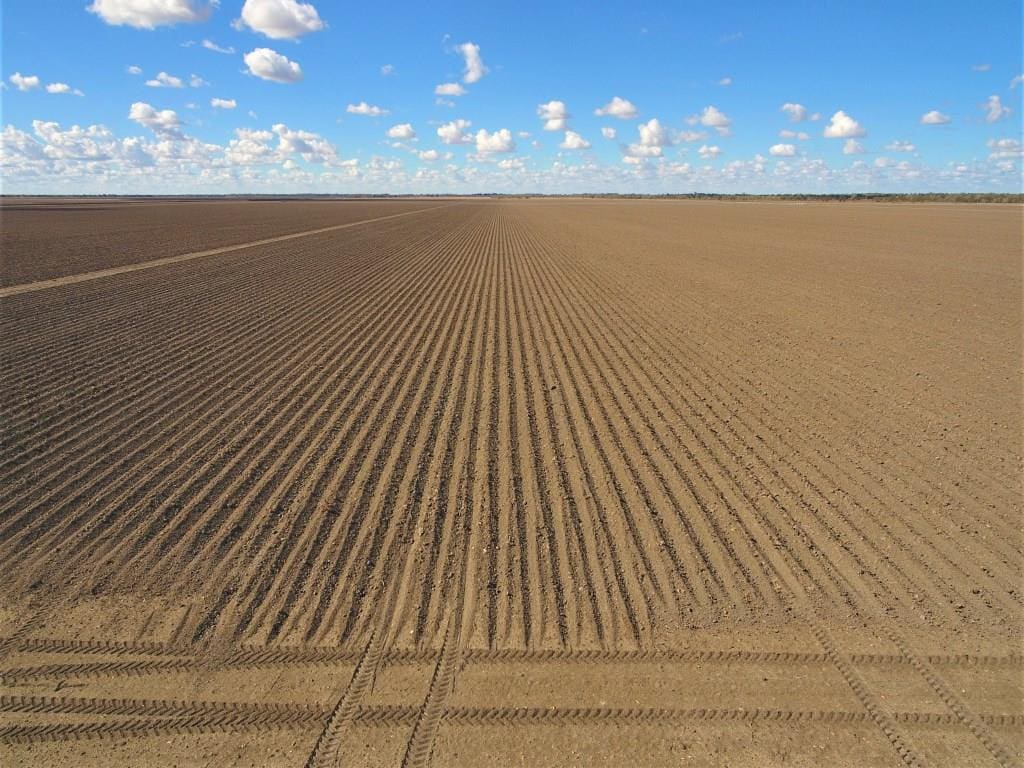
The Klamath Basin was created by draining several lakes in the area, including Tule Lake in the heart of the project. Water is circulated using a complicated labyrinth of interconnected waterways that includes 18 canals, 45 pumping plants and 516 miles of ditches. An average elevation of 4,000 feet provides natural pest protection due to cold winters.
Local potatoes – especially the Wanetas – are gobbled up by companies ranging from Frito Lay to In-N-Out Burger. Tule Lake horseradish is branded by name. Alfalfa is shipped to the Middle East because cows who eat Klamath Basin hay reportedly produce better tasting milk. Mike McKoen grows peppermint, which is used in everything from toothpaste to tea. He said the hardest part of the current drought is letting his workers go. “Employees are not a commodity,” he said. “These are long term relationships … and they are part of our family.”
Like most family farms, everyone is involved in the operation. McKoen’s son could drive a tractor at the age of four. An equipment shed still bears a scar from an early driver’s training incident. He said he tries to protect his kids from being fearful about the future but “they know.” “They ask why are the tractors still in the shed or where is Jose,” he said.
A Double Whammy
Complicating matters is Upper Klamath Lake, the second-largest fresh water lake in Oregon based on surface area with an average depth of six feet. A natural reef formed the original lake and the Klamath Basin reclamation project was designed to manage that water. The lake currently holds enough water to allow most folks to scrape by this summer or at least protect the root structure of their crops, irrigators said, but is being held back to protect fish.
The problem also extends all the way to the Pacific Ocean more than 250 miles away. The Pacific Fishery Management Council, a federal advisory body to the U.S. Department of Commerce, recommended last month that 200 miles of Northern California coastline be shut down for the entire 2021 commercial salmon fishing season due to dismal numbers of returning Chinook.
“Back-to-back closures like this cost coastal fishing-dependent families their livelihoods,” said Glen Spain, the organization’s regional director. He called this year a “double whammy” as salmon spend three years in the ocean before returning to their birthplace to spawn and die. “We are facing low returns of adult fish due to juvenile C. shasta-caused die-offs three years ago, but this year’s desperate drought conditions will encourage even more infections, likely sealing their fate and causing collapsed salmon fisheries three years from now,” he said.
In an attempt to negotiate a solution, more than 40 entities, including farmers, environmentalists and Klamath tribes, hammered out an agreement that included water rights in 2009. It was supposed to be a blueprint for the future of the West but died in a U.S. Congressional committee.
More than a decade later, there is a subtle but colossal shift in the power structure that formed the backbone of the original Klamath Basin Restoration Agreement. It involves the demolition of four antiquated dams on the Klamath River, with the hope that their removal will help restore salmon habitat. It provided an opportunity for Klamath Basin irrigators at the time, who said they would not oppose the dam removal in return for certain guarantees regarding water deliveries.
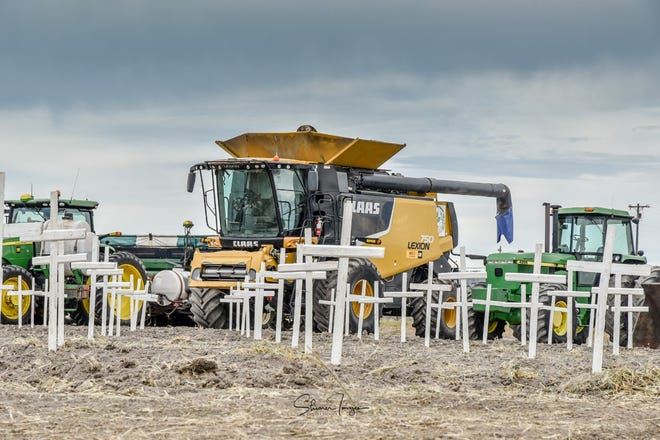
Now, however, even the dams’ owner, PacificCorp, based in Portland, Ore, wants them removed and, with the recent financial backing of both state governments in California and Oregon, the project appears more likely than ever to proceed. That has left Klamath Basin farmers with one less chip in the game.
“We have no leverage now,” said Dan Keppen, executive director of the Family Farm Alliance, which represents water rights in 17 western states. He said there are multiple stresses on Klamath River salmon, ranging from commercial fishing to logging. The result is that irrigators feel caught between competing biological opinions.
“The fish have not benefited … and progressively farmers are getting less and less water,” he said. “The system is so inflexible right now that you have a situation where you have (scientists) competing against one another, the lake is dropping and there is no human cause doing that except government regulatory agencies.”
The result is expected to be a long and tense summer.
‘When the Well’s Dry …’
More than 200 years ago Benjamin Franklin wrote that “when the well’s dry we know the worth of water.” For Claude Haggerty, a 35-year-member of the Tule Lake Irrigation District, those words recently took on a new meaning. Although Parkinson’s Disease is now waging a relentless war on his body, his mind remains sharp as ever.
He said not knowing what to do or whether to even plant a crop this summer comes at a stiff price. “The uncertainty cost me my oldest son,” he said. “He decided to get a job someplace else.”
